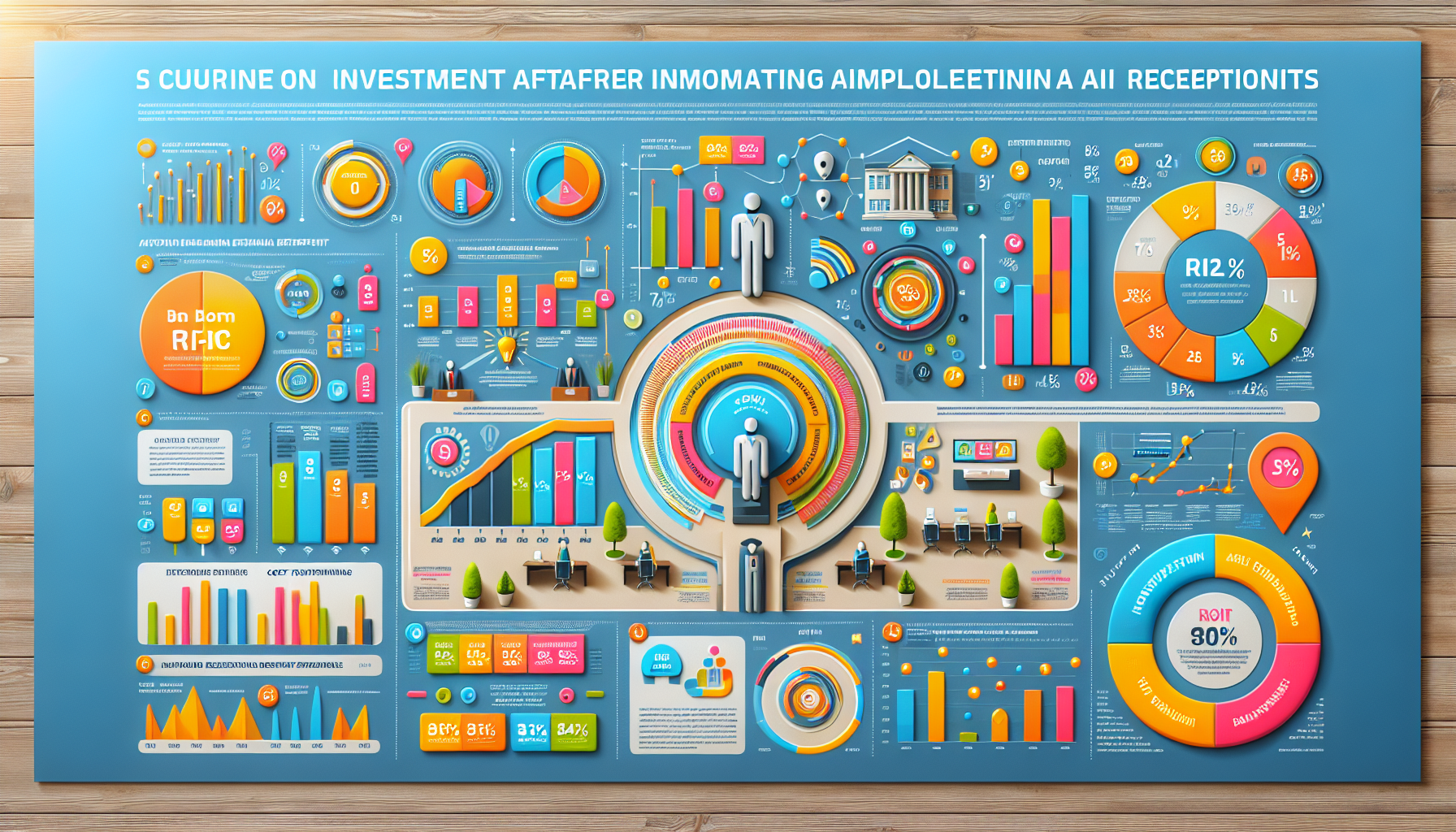
In an era where technology continues to streamline day-to-day activities, revolutionary tools like AI receptionists are changing the face of modern businesses. Welcoming guests, mapping out future meetings, and streamlining communication - these intelligent virtual assistants are redefining reception capabilities, with the promise of soaring productivity levels and enhanced customer experience.

Yet, as with any business move, investing in an AI receptionist requires a thoughtful understanding of return on investment (ROI). While the initial cost may appear substantial, it's integral to consider the long-term benefits and potential savings achieved through increased efficiency and reduced labor costs.
To determine whether an AI receptionist implementation has been successful, businesses must track their ROI. Assessing the financial impact of these innovative solutions involves a good grasp of all costs associated with the implementation as well as an evaluation of all monetary benefits resulting from the new system.
ROI measurement allows companies to objectively gauge the effectiveness of their AI receptionist, by scrutinizing its economic value and deciding whether this innovation is indeed a wise allocation of resources. By maintaining a data-driven approach to their analysis, businesses can make well-informed decisions based on tangible evidence rather than instinctive hunches.
Ultimately, a successful AI receptionist installation is one that brings increased financial gain through reduced manual work, improved client satisfaction, and greater work efficacy.
Implementing an AI receptionist is a technological leap that should indeed accrue benefits to your organization. However, evaluating its efficacy, a process necessitating clear Key Performance Indicators (KPIs), is an integral part of this transformation. These KPIs help measure the actual Return on Investment (ROI) against the expected, thereby tracking the overall success of your AI Receptionist system.
A few performance metrics stand out as crucial starting points to define your KPIs, namely: Call Handling Time, Customer Satisfaction Scores, and Call Volume Management.
In terms of Call Handling Time, the efficiency and speed of an AI receptionist in conducting client interactions is a significant sub-indicator of productivity increase. Lowered call handling time may signify higher efficiency, freeing up more time for your human employees to handle complex, high-value tasks. Proper evaluation systems should be put in place to assess this in comparison to previous receptionist models for a more comprehensive view.
Secondly, an AI receptionist should ideally lead to improved Customer Satisfaction Scores. Utilizing AI capabilities like machine learning can tailor more personalized, on-demand interactions with customers. Tools like the Net Promoter Score (NPS) can provide substantial insights into this element. An upward trend in these scores may denote that the AI receptionist implementation is positively impacting customer experience.
Lastly, successfully dealing with high Call Volume Management is another vital KPI under consideration. The AI receptionist’s capacity to manage simultaneous calls effectively without human intervention exemplifies business systems' efficiency. Quicker, accurate responses and minimal customer holding times are a reflection of well-handled call volume.
In conclusion, these outlined KPIs – when collectively analyzed – offer a decisive view on the success of your AI Receptionist implementation. Remember, the end-goal here is to drive enhanced productivity and elevated customer satisfaction. The focus should always revolve around exploring how AI's potential can be leveraged to the hilt for operational excellence, aspiring for more than just cost savings.
Implementing an AI receptionist can bring a myriad of benefits, including cost savings, enhanced customer service, and operational efficiency. However, harnessing its full potential involves integrating it with your existing business systems such as your CRM and analytics tools. This integration presents an opportunity to effectively measure the ROI of your AI receptionist and track its performance.

Once integrated with your CRM, the AI receptionist can directly input customer interactions data into your CRM. This provides a seamless way to track every interaction, from initial contact to final service or product delivery. Similarly, connecting your AI receptionist with your analytics tools allows for an in-depth analysis of these interactions and the overall performance of your AI receptionist. This could involve analyzing customer satisfaction rates, response times, and revenue generation - vital metrics for measuring ROI.
An integrated approach allows for better visibility into the impact of your AI receptionist on your overall business objectives. It presents you with real-time data on performance, helping you to pinpoint what's working and what might need to be tweaked. Consequently, you can make more informed decisions about needed updates, and can readily measure the return on your investment in the AI receptionist, using hard data to validate your expenditure.
What's more, the integration allows for a more collaborative work environment. Through your CRM and analytics tools, every team member can have access to the same performance data. This fosters a unified perception of how the AI receptionist is affecting overall business objectives and inspires teamwork for continual improvement.
However, achieving this level of integration and successfully tracking the performance of your AI receptionist requires careful planning and strategy. It's important to collaborate with a trusted AI service provider and invest in relevant training to ensure that your team is equipped to exploit the full capabilities of the new AI tools.
In conclusion, measuring the ROI from an AI receptionist would not be completely possible and straightforward without its integration with existing business systems like CRM and analytics tools. This powerful blend of technologies gives businesses a competitive edge by transforming customer interactions into a source of valuable insights for enhancing business growth and return on AI investments.
Any business looking to adopt a trend like AI receptionists should first consider the financial metrics involved and the projected savings. This can be achieved by conducting an in-depth cost-benefit analysis before implementation.
This detailed assessment takes into consideration factors such as the cost of buying or developing the AI receptionist solution, expenses associated with training staff, as well as maintenance and software updates. Comparing these with the expected benefits such as efficiency gains, improved productivity, and reduced receptionist spending can provide a clear indication of whether the investment will be worthwhile.
In evaluating operational cost savings, keep in mind that with AI, redundant tasks typically handled by human receptionists are automated, which can save significant operating costs in the long term. For example, AI receptionists can work 24/7 without overtime pay, vacation, or healthcare costs. By automating repetitive tasks, you minimize errors and increase efficiency, ultimately contributing to overall cost savings.
Next, consider the direct financial impacts of using an AI receptionist. A well-implemented AI receptionist can have a direct impact on the bottom line by increasing sales, enhancing customer satisfaction by addressing queries promptly, and improving the accuracy of data collection. By handling high volumes of calls and messages simultaneously, AI receptionists ensure that businesses do not turn away potential customers due to missed calls or delayed responses.
In summary, be sure to perform a comprehensive analysis of the various financial metrics and cost savings associated with implementing an AI receptionist solution. Doing so will ensure that you are well informed and positioned to make a decision that reaps long-term financial benefits for your business.
In the rapidly digitalizing world of business interactions, AI Receptionists are increasingly becoming a norm. This game-changing technology delivers value on various fronts - improving efficiency, minimizing errors, and enhancing customer experiences. Several industry leaders have already begun tapping into AI's potential by successfully integrating intelligent virtual receptionists into their business operations. Here, we explore a few remarkable cases to highlight the practical ROI that AI receptionists bring to the table.

Amelia, developed by IPsoft, is a notable example in the field of AI receptionists. It has transformed traditional front-desk operations with versatile functionality embedded in user-friendly interfaces. One of its famous implementation is by the multinational telecom company, Telefonica. Within the first year of adopting Amelia, Telefonica reported a significant reduction in operating costs, while enhancing customer service efficiency by 85%. The ROI was clear as daylight: a streamlined business workflow with a simultaneous boost in customer satisfaction.
Moving towards the retail industry, Sephora's Chatbot Assistant merits attention. This AI receptionist not only guides customers through product-selection processes but also offers personalized recommendations, enhancing ease of shopping. On employing the Chatbot assistant, Sephora celebrated an 11% uplift in booking rates, which translated into a considerable return on their investment.
Another successful AI receptionist application comes from the financial sector. Bank of America's Erica, has over 10 million users and has handled more than 100 million client requests. Data shows that users who interact regularly with Erica witnessed a 3-5% growth in their savings, pointing to the direct impact of the AI in boosting customer financial health and thus, enhancing client retention.
To conclude, these real-world implementations clearly demonstrate the tangible benefits of deploying AI receptionists, from increased operational efficiency to enhanced customer engagement. As more instances of successful AI receptionist implementations surface, businesses worldwide can gain more confidence in realizing a favourable Return on Investment from these intelligent and responsive virtual assistants.
The 'marvel of AI' journey doesn’t stop at AI Receptionist implementation. Close monitoring is essential to measure the return on investment (ROI) and to showcase its success. The beauty of AI is that it’s powered by data, and through that data, insights are readily available. The collected data can be analyzed, interpreted, and used to make more informed decisions about ongoing use and potential enhancements for the AI system.
Data analysis begins with definable metrics. If you’ve implemented an AI receptionist, key metrics to consider include average call duration, number of calls handled per day, customer satisfaction scores, or even cost savings as compared to prior solutions. These metrics can be captured through the AI system’s in-built analytics reporting functionalities or external tracking systems. Examples of such systems include Databox and HubSpot.
However, understanding which numbers to look at is only the starting point. The real task lies in interpreting the collected data. For instance, if the average call duration has visibly reduced, is it due to improved efficiency or a compromise on the quality of service? Similarly, if the AI Receptionist is managing more calls per day, is it because of growing demand or because human receptionists routinely missed calls? Therefore, each metric must be viewed in context.
In situations where the tracked metrics don’t seem sufficient or don’t provide a clear answer, additional data collection and analysis methods can be put in place. Customer feedback could be gathered through surveys or direct interviews. Such qualitative data, when paired with quantitative insights, can paint a fuller picture of the AI receptionist’s effectiveness.
By analyzing and interpreting your data effectively, you can make strategic decisions to enhance the functionality of your AI receptionist, optimize its usage, and boost its ROI. Normalizing this cycle of monitoring, analysis, planning, and execution will ensure that your AI investment yields the highest possible returns.
Remember, the feedback loop is vital; the data gathered from your AI receptionist can provide valuable insights into areas of improvement, leading to better functionality and stronger customer relationships. So, don’t just implement an AI receptionist; ensure you are charting its prospects and performance through diligent tracking and data analysis.
Start your free trial for My AI Front Desk today, it takes minutes to setup!








